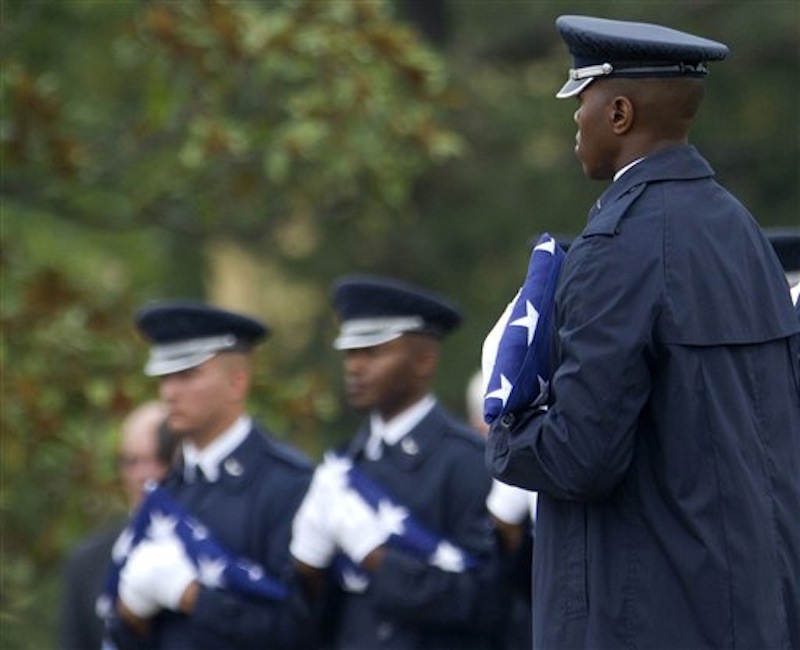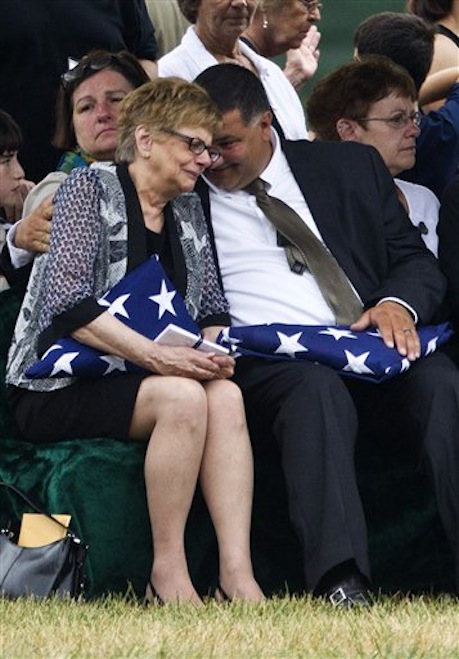ARLINGTON, Va. — Ever since Sherrie Hassenger’s husband went missing with five other U.S. airmen over Laos in 1965, her purpose has been to wish and to hope he would come home. When those men’s remains were buried in a single casket Monday at Arlington National Cemetery, she said, some of that purpose was taken away.
“All I listen to is ’50s, ’60s music,” she said. “When I saw those Air Force men in those dress blues, just like back then, I just wanted to go up and hug them and kiss them. It felt like maybe I could find a piece of my husband in them.”
The charred remains of the six airmen — identified not through DNA matches but through dental records, personal items and other circumstantial evidence — were buried in a single casket with full military honors, as is common in situations where remains can’t be conclusively linked to a specific individual. The remains are representative of six Air Force servicemen: Col. Joseph Christiano of Rochester, N.Y.; Col. Derrell B. Jeffords of Florence, S.C.; Lt. Col. Dennis L. Eilers of Cedar Rapids, Iowa; Chief Master Sgt. William K. Colwell of Glen Cove, N.Y.; Chief Master Sgt. Arden K. Hassenger of Lebanon, Ore.; and Chief Master Sgt. Larry C. Thornton of Idaho Falls, Idaho.
The Air Force gave all six posthumous promotions, a military spokeswoman said.
It was Christmas Eve 1965 when their Air Force plane, nicknamed “Spooky,” took off from Vietnam for a combat mission. The crew sent out a “mayday” signal while flying over Laos, and after that, all contact was lost. Two days of searches turned up nothing.
For nearly half a century, the airmen’s families endured an emotional kaleidoscope that they say is difficult to describe to those who never had to face it. The men were listed for years as missing, and family members held out hope at first that their loved ones had survived. For most that hope faded over time, despite an occasional unconfirmed report that crew members were seen alive. The crash site has been excavated several times over the past decade, but it was not until 2010 and 2011 that human remains were recovered.
Even though Sherrie Hassenger’s husband perhaps had the most conclusive identification of all six crew members — a tooth of Hassenger’s was recovered and matched through dental records — she and her son Keith Hassenger said they still have nagging doubts about what happened. Both said they appreciated Monday’s service and were grateful so many people came to pay respects, but they said they have had a difficult time getting answers over the years. The tooth, in their mind, raises more questions than answers: If a single tooth was found, they wonder, wouldn’t it make sense that other teeth or perhaps his skull could be found also?
Keith Hassenger said that while they approached Monday’s service with the feeling it might help provide closure, that comfort proved elusive.
“This may be the only thing we get,” he said.
For Jeanne Jeffords, 86, of Temecula, Calif., the hardest part of Monday’s service was seeing how emotional it was for her children, who were teenagers when their father died.
“I’ve lived with it for so long, I’m all teared out,” said Jeffords, who appreciated the opportunity to meet the families of her husband’s fellow airmen. “For all these years we just had a list of names.”
The service drew hundreds of people, including Air Force and Vietnam veterans unrelated to the families.
Curtis Eilers, who was 3 when his father died, admitted he was taken aback that so many people have been interested in his father’s story and attended Monday’s service. Many strangers also attended a service for his father in Iowa.
“I didn’t know that anybody else would be interested,” he said. “I never thought of my dad as a hero.”
He said he was impressed by the efforts to identify the crew members.
The first joint U.S.-Laotian team didn’t visit the crash site until 1995 in the southern province of Savannahket, which was heavily bombed during the war as it lay on the Ho Chi Minh supply route that supplied Vietcong communist guerrillas in southern Vietnam. A villager recalled seeing a two-propeller aircraft crash near the village. A second villager had found wreckage of it and took the team to the crash site.
Follow-up teams revisited the site four times between 1999 and 2001 and recovered military equipment but no human remains, and excavation was suspended.
Excavations resumed in 2010 and 2011, when human remains and personal items from the crew were found.
It is not uncommon in situations like these for joint sets of remains to buried at Arlington. The Pentagon’s Defense POW/Missing Personnel Office lists more than 83,000 service members as missing in action, the vast majority from World War II. In 2011, the office identified the remains of 62 service members previously unaccounted for.
Jeffrey Christiano of Rochester, N.Y., who was only 2 when his father’s plane went down, said Monday’s burial brings his father home and resolves “this nagging, disjointed feeling that he’s not where he belongs.”
He said he has struggled to understand his own emotions in the months since learning that his father’s remains had been found and would be buried at Arlington.
“Most people learn about their father by experiencing them. I had to consciously make the effort to put the picture of my father together myself,” he said, and in many ways he put that picture together through the lens of the decades-long search to discover what happened. Now that the search is finally over, he said, “today’s the day he dies, for me.”
Send questions/comments to the editors.




Success. Please wait for the page to reload. If the page does not reload within 5 seconds, please refresh the page.
Enter your email and password to access comments.
Hi, to comment on stories you must . This profile is in addition to your subscription and website login.
Already have a commenting profile? .
Invalid username/password.
Please check your email to confirm and complete your registration.
Only subscribers are eligible to post comments. Please subscribe or login first for digital access. Here’s why.
Use the form below to reset your password. When you've submitted your account email, we will send an email with a reset code.